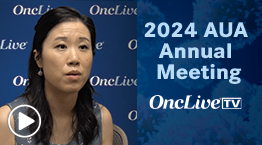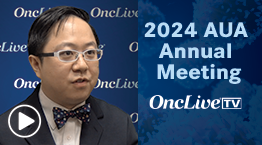Biosimilar Trastuzumab Matches Herceptin in Efficacy and Safety
A biosimilar version of trastuzumab demonstrated equivalent efficacy and safety to the FDA-approved branded drug in a randomized phase III study among patients with HER2-positive metastatic breast cancer.
Hope Rugo, MD
A biosimilar version of trastuzumab (Herceptin) demonstrated equivalent efficacy and safety to the FDA-approved branded drug in a randomized phase III study among patients with HER2-positive metastatic breast cancer in findings expected to open the door to a less-expensive version of one of the world’s top-selling oncology drugs, according to research being presented at the 2016 ASCO Annual Meeting.1
The antibody MYL-1401O demonstrated an overall response rate (ORR) after 24 weeks of 69.6% among women who received the biosimilar in combination with a taxane compared with a 64% ORR for patients who took Herceptin plus a taxane. The ratio of ORR for MYL-1401O to Herceptin was 1.09; both 90% CI (0.974-1.211) and 95% CI (0.954-1.237) were within the predefined equivalence margin.
Safety data also were comparable. Serious adverse events (SAEs) occurred in 38% of the patients in the MYL-1401O arm compared with 36.2% in the Herceptin arm, with neutropenia as the most frequently reported SAE in both arms (27.5% vs 25.2%, respectively). There were 4 fatalities in each arm of the trial and, notably, no significant change in cardiac function from baseline to week 24 in either group, according to the conference abstract.
The Heritage study evaluating MYL-1401O represents one of the first trials in which an oncology biosimilar has shown similar efficacy, safety, and immunogenicity against the reference product, said lead investigator Hope S. Rugo, MD, a professor of Medicine and director of the Breast Oncology Clinical Trials Program at the UCSF Hellen Diller Family Comprehensive Cancer Center, during an ASCO presscast.
The results indicate that MYL-1401O can potentially meet the need for an affordable treatment option for patients with HER2-positive cancers, particularly outside the United States where access can be restricted because of pricing considerations, said Rugo.
“It is expected that having biosimilars will reduce the costs by some amount worldwide for these agents,” said Rugo. “In the United States, most patients have insurance coverage that covers branded trastuzumab and we haven’t had any other option. I have not ever seen a situation where it wasn’t covered for a standard indication. In the US, it’s less of a financial issue in terms of access to drugs but having alternative agents will be important worldwide.”
The cost of a course of trastuzumab treatment for breast cancer has been estimated at $44,000 to $65,000 per year in the United States,2 although Rugo noted that such estimates vary. US public health officials have been looking toward biosimilars to help moderate healthcare spending.
Although biosimilar drugs are available in Europe and other countries, the FDA approved the first biosimilar for the US market in March 2015. Zarxio (filgrastim-sndz) was approved as a biosimilar to Neupogen (filgrastim), a supportive care drug with several cancer indications including for patients undergoing myelosuppressive chemotherapy or bone marrow transplantation.
The FDA defines a biosimilar as a biological product, derived from a living organism, that is approved based on whether it is shown to be highly similar to an already approved biological product with no clinically meaningful differences in terms of safety and effectiveness from the reference product. Herceptin is a humanized monoclonal antibody produced by DNA technology in a Chinese hamster ovary culture.
If approved, MYL-1401O would be the first oncology therapeutic biosimilar available in the United States. Mylan NV, the generic and specialty pharmaceutical company developing the drug along with Biocon Ltd, said it expects to submit biosimilar applications for MYL-1401O in the United States and Europe within the next several months.
The move toward biosimilars is likely to accelerate in the near future. Clinical trials involving biosimilars of other oncology drugs such as rituximab (Rituxan) and bevacizumab (Avastin) are ongoing and are expected to reach the market in the “near future,” ASCO said in a press release.
A version of MYL-1401O already has been approved in India, where it has been used by patients with no access to Herceptin, generating additional safety and pharmacovigilance data, said Rugo. “There is actually quite a substantial body of safety data for this agent,” she said.
In the Heritage trial, 500 patients with measurable HER2-positive metastatic breast cancer who had not received prior chemotherapy or trastuzumab for metastatic disease were randomized to receive either MYL-1401O or Herceptin with docetaxel or paclitaxel. Response data were reported for 458 patients, including 230 in the MYL-1401O arm and 228 in the Herceptin arm.
Participants were treated for a minimum of 8 cycles, with trastuzumab continuing until progression. Both forms of trastuzumab were administered with a loading dose of 8 mg/kg and a maintenance dose of 6 mg/kg every 3 weeks.
The primary endpoint was ORR. Secondary endpoints included progression-free survival, overall survival, time to progression, safety, and tolerability.
In discussing the trial results, ASCO spokesman Don Dizon, MD, noted Herceptin’s place in the history of oncology therapeutics. “More than a decade ago, trastuzumab transformed the outlook for women with HER2-positive breast cancer as part of a new generation of targeted drugs that radically changed the way we treat cancer,” he said. “These initial data provide support that a biosimilar agent to trastuzumab is comparable to trastuzumab.”
Initially approved in 1998, Herceptin is indicated in HER2-overexpressing breast cancer in adjuvant and metastatic settings as well as in HER2-positive gastric cancer.
Although some industry analysts have speculated about whether US oncologists would embrace biosimilars, Rugo indicated she would use an approved product. “If a biosimilar is approved and meets regulatory approval, I would be happy to use it as an alternative to the branded product,” she said.
At the same time, Rugo noted that market realities would also play a role. “In truth, if the insurance companies say, you’re going to be using this biologic, that’s what we are going to be using in the US,” she said.
References
- Rugo HS, Barve A, Waller CF, et al. Heritage: a phase III safety and efficacy trial of the proposed trastuzumab biosimilar Myl-1401O versus Herceptin. J Clin Oncol. 2016;34(suppl; abstr LBA503).
- Goddard KAB, Weinmann S, Richert-Boe K, et al. HER2 evaluation and its impact on breast cancer treatment decisions. Public Health Genomics. 2012;15(1):1-10.



